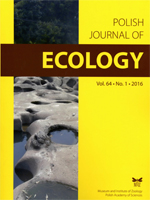The human induced changes affect the transformation of different plant communities. In some cases this process can contribute to increase in local biodiversity, but it depends on type and manner of human activity involved. The main aim of this study is to answer the question how two anthropogenic factors (former and current) can modify the species composition in forest phytocoenoses.
The study area is situated in the southern Poland (Małopolska Upland). The studies were carried out on two former (19th century) mining fields where planting Common Beech Fagus sylvatica (field A) and Scots Pine Pinus sylvestris (field B) have been done since the first half of the 20th century.
On gob piles (sites transformed by former iron-ore mining), single-species beech (field A) or pine (field B) tree stands are undergoing secondary succession, and transform into multi-species, fertile deciduous forests. This secondary communities corresponding to the types of new, fertile soils (formed by clayey-loamy material of gob piles), generated as a result of mining activities. Whereas, on non-transformed areas forest communities with floristic structures and composition linked to poor and acidophilous phytocoenoses developed. These communities are also compatible with their respective, primary habitats (acid, poor, and sandy soils).
Nonetheless, the secondary succession of forest communities on gob piles can be disturbed. In the herb layer of fertile habitats of post-mining sites where Pinus sylverstis was planted (field B) acidophilous species among mesophilous forest species were noted. This process of acidification of humus layer is induced by the fall of needles of pines and it has not been observed in communities with planted Fagus sylvatica (field A).
It was found that previous mining activities now affect the secondary succession in the forest communities of northern part of the Małopolska Upland because they have created new habitats where process of forming mesophilous phytocoenoses was observed. Accordingly, former human activity leads to the increase in local biodiversity. On the other side current forest management can reduce this effect as a result of planting tree species which acidify these fertile habitats and suppressed the occurrence of mesophilous forest species, what, by contrast, decrease the species richness.





